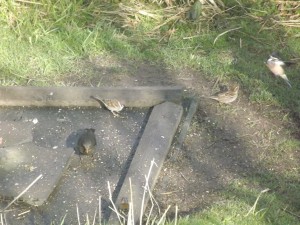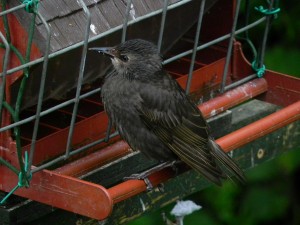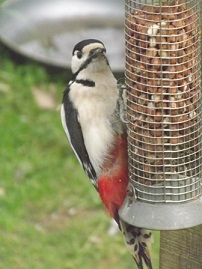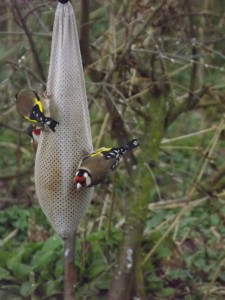Your wildlife garden part 3 – Feeders and plants.
Now that you’ve decided which birds you want to attract to your garden and bought the right food to attract them, the next step is to choose the right feeder. This will not only ensure that you feed your birds responsibly, but also means you can choose where you place the feeders in your garden to help give you the best opportunity to watch the visiting birds . Which type of feeder you buy will depend greatly on the types of food you want to provide.
If you want to start attracting garden birds straight away, but don’t have any feeders, then feeding on the ground is the easiest option. The food should be scattered over a wide area and out in the open, reducing the chance of predation by ground predators. It’s also important to regularly change the area where you scatter the food for hygiene reasons and clean any hard surfaces that the food is placed on. While most British bird species will happily feed on the ground, in fact dunnocks and thrushes prefer it, many will prefer feeders if they are available. Bear in mind, though, this method of feeding also feeds other wildlife as well, including foxes, badgers, and hedgehogs, as well as rats and mice. Raised feeders allow you to target mainly birds, but its still worth encouraging ground feeding on a smaller scale to still attract ground feeding species.

Bird tables are suitable for most types of bird food, and attract a range of species, including robins, blackbirds, and sparrows. Bird tables should be at least 1m2 in size with the food spread out across evenly across them to ensure that a number of birds can feed at the same time. Look for tables with rimmed sides to reduce the amount of food lost during feeding and with gaps in the corners to drain away rain water. Keeping them 1 – 2m off the ground and out in the open will ensure that cats and squirrels can’t jump onto them. Ensure that you regularly remove any uneaten seed and that the table is cleaned thoroughly on a weekly basis.

Hanging feeders are now the most popular form of holding bird food and are great for attracting birds such as greenfinches, siskins, blue and great tits, and even greater spotted woodpeckers. For the most part, these come in two varieties. The steel mesh feeders are for nuts and are the only way in which this food type should be offered to wild birds. Mesh size is important here, especially if you are making your own feeders. It needs to be small enough to prevent the birds from removing the nuts whole, but large enough to ensure that they do not break their beaks while eating, with 6mm being the recommended size.

Seed feeders are made from plastic tubes containing holes through which the birds can feed. They are designed to hold large seeds like sunflowers and mixed seeds. Smaller seeds, such as Niger seeds, tend to require more specialised feeders, to reduce the amount of wastage, and here at the Visitor Centre we make our very own Niger bags. While these feeders usually hang from hooks, feeders can be bought which attach to your window, allowing you to watch them much more closely (as long as you remain still). But remember to place feeders around the garden to also benefit shyer species. As with all feeders, old food should be removed regularly, the feeder checked to ensure it is well drained, and cleaned on a weekly basis.

If you want to make your own feeders, half-coconuts, tit bells (made from flower pots and string), and plastic cups can all be filled with a fat mix. Hung from other feeders or trees these will attract house sparrows, tits, and greenfinches. Thick branches and logs, drilled with holes and hung off the ground, can be filled with lard, fat mixture, or peanut butter. These will attract the more agile birds, such as tits, woodpeckers, treecreepers, and sometimes wrens.
Through the spring and summer months it’s also important to ensure that there is a steady supply of insects in your garden. As pollinators and decomposers, insects play a critical role in a healthy ecosystem and could be the main focus of your gardening endeavour in their own right. However, they also play an important role in the breeding behaviour of many birds, being the main source of food for their chicks, leading many bird species to coincide their breeding patterns with that of their insect foodstuffs emergence.
There are some key, but simple things that can be done to any garden to ensure that its insect friendly. Firstly, a pond, even a small one, is great for all wildlife and will attract pond-skaters, water beetles, dragonflies, and damselflies a lot faster than you might expect. Allowing some of your lawn to remain untrimmed provides longer grass for a variety of egg laying insects, such as butterflies and moths, and leaving areas of the garden where vegetation is allowed to decay naturally also provides a home and food source for a number of beetles. Taller flowering plants, especially those with flat flower heads, will attract flying insects like bees and dragonflies, and of course, it’s important to plant species that flower at different times to ensure that insects visit your garden throughout the year supplying a steady source of food for the multiple broods many birds will have throughout the summer. Some of the plants recommended by the Royal Horticultural Society’s Plants for Bugs include sunflowers, foxgloves, thyme, lavender and honeysuckle. In exposed gardens along the coast, putting up wind breakers with trellises and wall climbing plants, will not only shelter many invertebrates from the worst of the weather, but also provide a link between gardens for many pollinators. Reducing the use of insecticides is also key and now is a great time to start building your own bug home to provide insects with shelter over the winter, ensuring a ready supply of food for next years’ chicks.
Georgina Bowie, Visitor Centre Assistant
Help protect Scotland’s wildlife
Our work to save Scotland’s wildlife is made possible thanks to the generosity of our members and supporters.
Join today from just £3 a month to help protect the species you love.
Preface
Now that you’ve decided which birds you want to attract to your garden and bought the right food to attract them, the next step is to choose the right feeder. This will …
